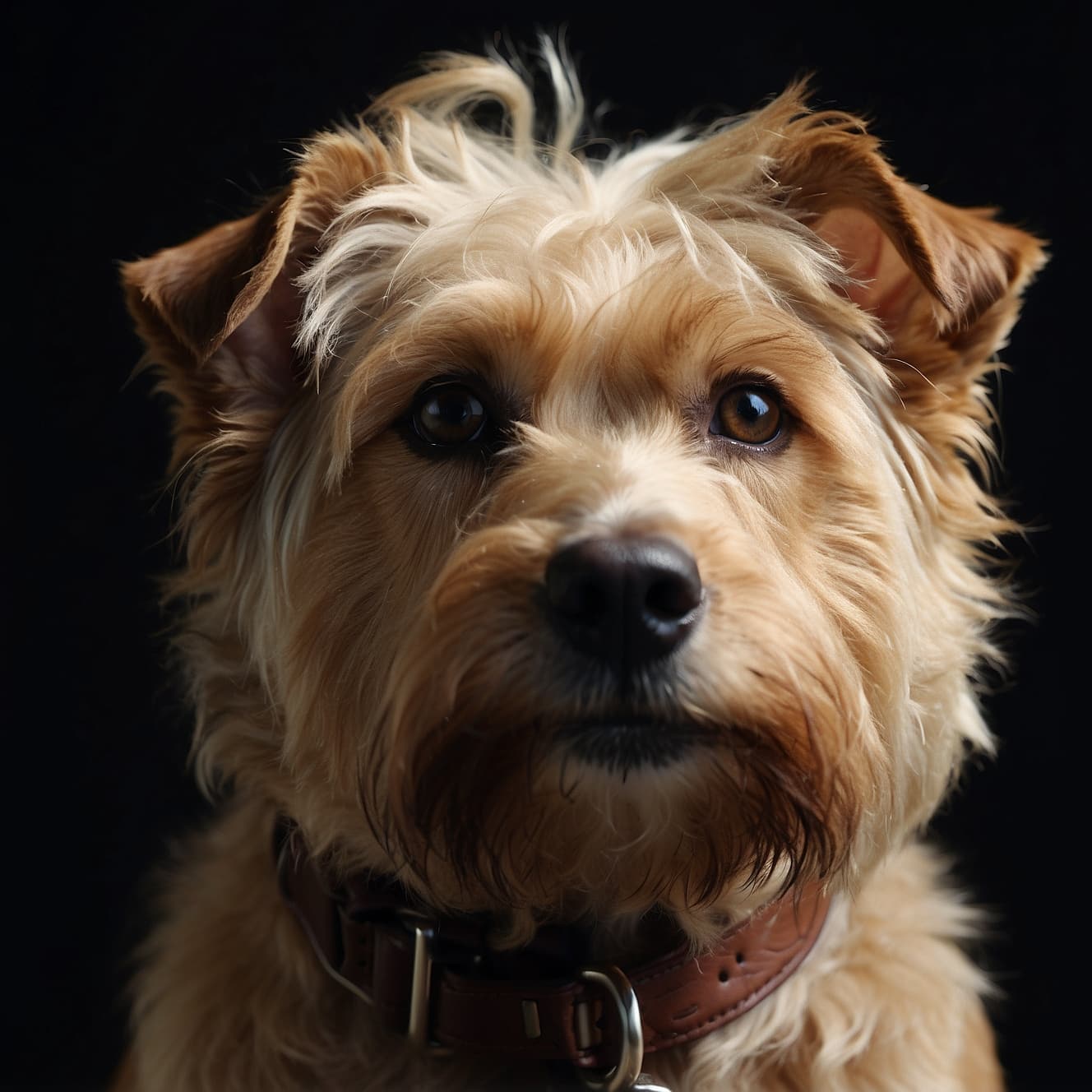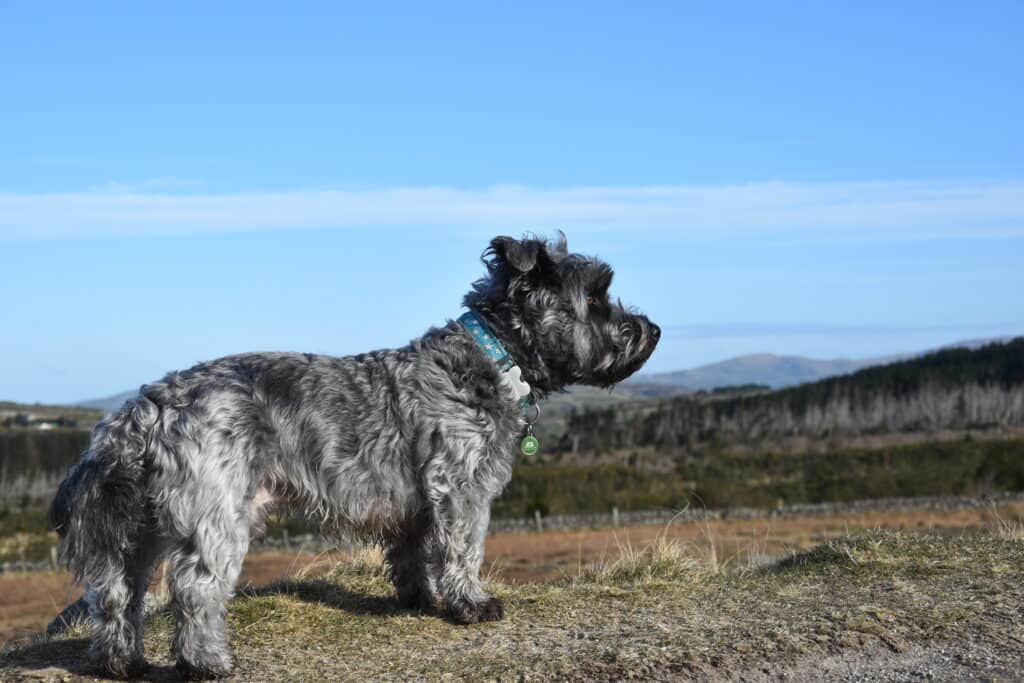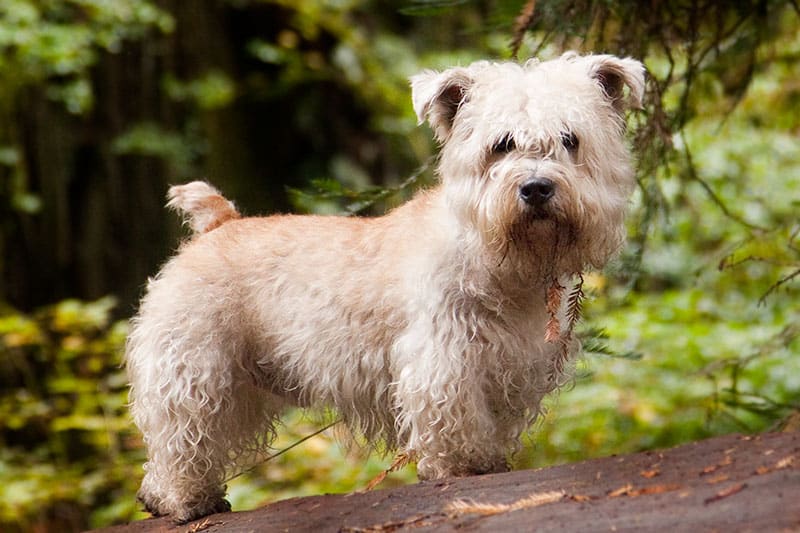Glen of Imaal Terriers have a history rooted in the rugged Glen of Imaal in Ireland. Dive into their heritage, understand the care they need, and appreciate the resilience and affection that make Glen of Imaal Terriers special.

| Category (Explanation) | Breed Information |
|---|---|
| Year of Breed Conception | 16th century |
| Country of Origin | Ireland |
| Weight (lbs & kg) (Male) | 32-35 lbs (14.5-16 kg) |
| Weight (lbs & kg) (Female) | 25-28 lbs (11.5-12.5 kg) |
| Coat Type | Medium-length double coat |
| Color Variations | Blue brindle or wheaten |
| Shedding Level (Low, Moderate, High) | Low to Moderate |
| Height (cm & in) | 12.5-14 inches (32-36 cm) |
| Breed Size | Small to medium |
| Trainability (Low, Moderate, High) | Moderate |
| Mental Needs (Low, Moderate, High) | Moderate |
| Intelligence Level (Low, Moderate, High) | Moderate |
| Energy Level (Low, Moderate, High) | Moderate |
| Agility (Low, Moderate, High) | High |
| Loyalty (Low, Moderate, High) | High |
| Playfulness (Low, Moderate, High) | Moderate |
| Exercise Needs | Moderate exercise and playtime |
| Guarding Proficiency (Low, Moderate, High) | Moderate |
| Sociability with Children (Low, Moderate, High) | Moderate |
| Barking Level (Low, Moderate, High) | Moderate |
| Digging Tendency (Low, Moderate, High) | Moderate |
| Destructive Behavior (Low, Moderate, High) | Low |
| Drooling Level (Low, Moderate, High) | Low |
| Obedience Level (Low, Moderate, High) | Moderate |
| Apartment Friendly (Yes/No) | Yes, can adapt to apartment living with sufficient exercise |
| Inherent Prey Drive | Moderate |
| Physical Risk to Others (Low, Moderate, High) | Low |
| Travel Fatality Risk (Low, Moderate, High) | Low |
| Allergen Potential | Low |
| Health Concerns (List of Common Health Concerns) | Hip Dysplasia, Progressive Retinal Atrophy |
| Average Life Expectancy (Life Expectancy in Years) | 12-15 years |
Woof Mastery is reader supported and our articles may contain affiliate links.
Instead of running third party ads that we have no control of we only use links from high-quality companies we are directly partnered with. Making use of these links come at no cost to you our reader, and in many cases have the extra benefit of discounted rates or sign up bonuses.
If you’re interested you can read more about our affiliate policy here.
We appreciate your support and always insure that the products and services we recommend are high-quality, helpful and relevant to the subject at hand!
Glen of Imaal Terriers have a history rooted in the rugged Glen of Imaal in Ireland. Originating in Ireland, they were bred for various tasks, including hunting and guarding. Their resilient and affectionate nature made them well-suited for these roles. Over time, Glen of Imaal Terriers transitioned from working dogs to cherished family pets. Their resilience and affection have endeared them to families who appreciate their spirited and gentle character.

Glen of Imaal Terriers have a history rooted in the rugged Glen of Imaal in Ireland. What makes them special is their history, resilience, and affection. Dive into their heritage, learn about the care they need, and appreciate the resilience and affection that make Glen of Imaal Terriers special. Glen of Imaal Terriers are special for their rugged history and the affectionate nature they bring into the lives of their owners.
The Glen of Imaal Terrier’s traditional role can be traced back to its origins in the rugged Glen of Imaal in Ireland. In this demanding terrain, these sturdy terriers were valued for their hunting prowess, used for hunting small game like foxes and badgers. Their resilience and determination made them well-suited for this challenging task, and their affectionate nature endeared them to their human companions.
Glen of Imaal Terriers have a history rooted in the rugged Glen of Imaal in Ireland. They are characterized by their resilience and affection. These terriers can be loving and make great companions. They are known for their history and require training and socialization to ensure they are well-behaved and affectionate companions.
Glen of Imaal Terriers have a history rooted in the rugged Glen of Imaal in Ireland. They are typically resilient and affectionate dogs. While they can be loving with their families, they may exhibit stubbornness at times. Training and socialization are crucial to ensure they develop into well-adjusted pets. Their strength and unique appearance make them stand out among terrier breeds.
Glen of Imaal Terriers are small dogs with a wiry, dense coat that comes in shades of blue brindle or wheaten. They have a well-proportioned body with a distinctive topknot and small, expressive eyes. Glen of Imaal Terriers have small, V-shaped ears that stand erect and a straight tail. They have a resilient and affectionate gait, reflecting their rugged and loyal nature.
Glen of Imaal Terriers have a rough, weather-resistant coat that comes in various colors. Common coat colors include blue brindle, wheaten, and blue. Their coat may have darker or lighter shadings, adding to their rustic and unique appearance. The variation in coat colors reflects their hardy and affectionate nature.
Glen of Imaal Terriers have a double coat that is dense and wiry. Their coat colors often include blue brindle, brindle, wheaten, or blue. The rugged appearance of their coat adds to their distinctive and charming look.
Glen of Imaal Terriers have a low shedding level. They have a medium-length, harsh coat that benefits from regular grooming. Brushing helps manage shedding and maintains the coat’s texture. While they shed minimally, attention to their grooming needs and occasional grooming sessions contribute to reduced shedding. Overall, Glen of Imaal Terriers are considered to be a breed with low maintenance in terms of shedding.
Glen of Imaal Terriers have a medium-length, harsh coat that requires regular grooming to maintain its quality.
Brushing: Regular brushing, 2-3 times a week, helps remove loose hair and prevents matting. Use a slicker brush or a comb suitable for their coat.
Stripping: Glen of Imaal Terriers may require hand-stripping to maintain the texture of their coat. This is typically done by a professional groomer.
Bathing: Occasional baths, using a mild dog shampoo, help keep the coat clean. Thoroughly rinse and dry after the bath.
Ears: Regularly check and clean their ears to prevent wax buildup or infections. Use a damp cotton ball or a veterinarian-recommended ear cleaning solution.
Nails: Keep their nails trimmed to a comfortable length, as long nails can cause discomfort and affect their gait.
Teeth: Brush their teeth regularly to maintain good oral hygiene. Dental chews or toys can also be beneficial.
Eye Care: Monitor their eyes for signs of irritation or discharge. Clean the eye area with a damp cloth if necessary.
Glen of Imaal Terriers have a moderate to high activity level. These sturdy and compact terriers enjoy physical activities and playtime. Daily walks, interactive games, and engaging activities are important for their physical and mental well-being. Glen of Imaal Terriers may also participate in activities such as agility. While they are not excessively hyperactive, regular exercise is crucial to prevent boredom and maintain good health. Tailor their activities to their age and individual preferences, providing a mix of physical and mental stimulation for a happy Glen of Imaal Terrier.
Glen of Imaal Terriers are known for their intelligence, marked by problem-solving abilities, resilience, and a desire to please their owners. They are generally trainable and responsive to positive reinforcement training methods. Glen of Imaal Terriers can learn various commands and tasks. Their resilience allows them to adapt to different living environments. Historically, they were skilled in roles such as hunting and guarding, showcasing social intelligence by forming strong bonds with their families. While they may not top the charts in terms of obedience, their intelligence makes them excellent companions and working dogs. Training, socialization, and mental stimulation contribute to their well-rounded and obedient nature.
Australian Terriers have a high level of energy and intelligence. Mental stimulation is crucial to prevent boredom-related behaviors. Engage them in activities like puzzle games, obedience training, and interactive play to keep their minds active and healthy.
Social Interaction: Australian Terriers are social dogs and thrive on human companionship. Regular social interaction with family members and exposure to different environments contribute to their mental well-being.
Exercise: Physical exercise is essential to burn off their energy, but mental exercise is equally important. Incorporate activities that challenge their problem-solving skills and keep them mentally stimulated.
Training and Obedience: Australian Terriers respond well to positive reinforcement training. Regular training sessions not only teach them commands but also provide mental exercise and strengthen the bond between the dog and owner.
Exploration: Allow them opportunities for exploration, whether in a secure backyard or during walks. Their curious nature benefits from new experiences and environments.
Playtime: Interactive play, such as fetching and tug-of-war, provides both physical and mental exercise. Rotate toys regularly to keep them engaged and prevent boredom.
Problem-Solving: Introduce puzzle toys and games that challenge their problem-solving abilities. This mental stimulation is essential for their overall well-being.
Consistency: Maintain a consistent daily routine, including feeding, playtime, and walks. Australian Terriers thrive on predictability and routine.
Enter The Woof Mastery

Prospective owners of Glen of Imaal Terriers should be aware of their specific characteristics and care requirements. These dogs are known for their intelligence, energy, and resilient nature. Regular exercise and mental stimulation are crucial to keep them happy and prevent boredom. Potential owners should be prepared for grooming needs and committed to providing a loving, active environment. Early training and socialization contribute to their well-rounded behavior. Responsible ownership includes understanding their exercise needs and ensuring they are part of a caring family.
Glen of Imaal Terriers, known for their resilience and affectionate nature, generally pose a low risk to others. Proper socialization and training contribute to positive interactions. Responsible ownership, understanding individual temperament, and adherence to local regulations play crucial roles in ensuring a well-behaved Glen of Imaal Terrier.
Glen of Imaal Terriers are known for their gentle and affectionate nature. They can be good with children, but supervision is important during play. Early socialization and positive reinforcement training contribute to positive interactions. Teaching children how to approach and interact with the dog is important.
Glen of Imaal Terriers may have varying responses to water. Some individuals may enjoy swimming, while others may not be as comfortable. If you plan to introduce them to water, do so gradually and observe their comfort level. Always prioritize safety and use a canine life vest if needed, especially in situations where they may be at risk of fatigue.
Glen of Imaal Terrier puppies, with their calm demeanor, respond well to positive training methods. Building a strong bond through training ensures a well-behaved and happy adult dog.
Glen of Imaal Terriers may exhibit moderate barking tendencies. They are alert and may bark to alert their owners or express themselves. Early training and socialization play a crucial role in managing their barking behavior and teaching them appropriate times to vocalize.
Glen of Imaal Terriers are adaptable and can live in different environments. They do well in homes with yards for play, but they can also adapt to apartment living if exercised regularly. Regular walks and mental stimulation contribute to their well-being. Glens enjoy being part of the family and thrive on attention. Early socialization and positive reinforcement training help in shaping their behavior positively.
Glen of Imaal Terriers are generally adaptable to travel conditions. Ensure they are securely restrained in the vehicle using a crate or a suitable seatbelt harness. Monitor for signs of stress or discomfort and provide breaks for exercise. Familiar items and positive reinforcement can contribute to a positive travel experience for Glen of Imaal Terriers. Plan for regular breaks during long journeys to ensure their well-being.
Glen of Imaal Terriers may be prone to specific health concerns. While not all individuals will experience these issues, it’s essential for Glen of Imaal Terrier owners to be aware of potential health problems and work with veterinarians to maintain their pets’ well-being. Common health concerns in Glen of Imaal Terriers include:
Regular veterinary check-ups, a balanced diet, proper exercise, and responsible breeding practices can help mitigate some of these health concerns. It’s crucial for Glen of Imaal Terrier owners to work closely with their veterinarians to monitor their pets’ health and address any issues promptly.
Proper nutrition is essential for the health and well-being of Glen of Imaal Terriers. Here are some nutritional habits and best practices to consider for this breed:
Breed-Specific Laws (BSL): Glen of Imaal Terriers may be subject to breed-specific laws (BSL) in certain areas. These laws are often enacted at the local or municipal level and can vary widely from one jurisdiction to another.
Types of Restrictions: The specific restrictions imposed on Glen of Imaal Terriers under BSL can include mandatory spaying/neutering, special licensing, liability insurance requirements, muzzling in public, and, in some cases, bans on ownership. The severity of these restrictions depends on local regulations.
Rationale for BSL: BSL is typically implemented based on concerns about public safety and perceived risks associated with specific breeds, often due to incidents involving dog attacks. While Glen of Imaal Terriers are not inherently aggressive, they can be affected by BSL due to their physical resemblance to breeds that are sometimes included in these laws.
Controversy: It’s important to note that BSL is a controversial topic. Critics argue that it unfairly targets breeds rather than addressing individual dog behavior and that responsible ownership and training should be emphasized instead of breed-specific restrictions.
Local Regulations: To determine if there are breed-specific laws or restrictions regarding Glen of Imaal Terriers in your area, you should check with your local animal control or government authorities. Be aware of and comply with any local regulations to ensure that you are in compliance with the law while owning a Glen of Imaal Terrier.
Woof Mastery is reader supported and our articles may contain affiliate links.
Instead of running third party ads that we have no control of we only use links from high-quality companies we are directly partnered with. Making use of these links come at no cost to you our reader, and in many cases have the extra benefit of discounted rates or sign up bonuses.
If you’re interested you can read more about our affiliate policy here.
We appreciate your support and always insure that the products and services we recommend are high-quality, helpful and relevant to the subject at hand!
Myth 1: Glen of Imaal Terriers are Aggressive
Myth 2: They are Not Good with Children
Myth 3: They are Difficult to Train
Myth 4: They Require Excessive Grooming
Myth 5: They are Not Social Dogs
Myth 6: They are Not Playful
Myth 7: They are Only Suitable for Active Owners
Myth 8: They are Prone to Health Issues
Myth 9: They Don’t Get Along with Other Pets
Myth 10: They are Not Good Guard Dogs
These myths highlight the importance of understanding the individual nature of Glen of Imaal Terriers and the impact of proper training and socialization on their behavior. When given the right care, they can be delightful and adaptable companions.
Famous Glen of Imaal Terrier examples are not as widely documented, but these sturdy and affectionate dogs can be found as cherished pets in homes where their unique characteristics are valued.
The Glen of Imaal Terrier holds cultural significance in various aspects:
The Glen of Imaal Terrier, named after the Glen of Imaal in Ireland, does not have a widely recognized historical owner. However, Glen of Imaal Terriers have been appreciated for their sturdy build and friendly demeanor.
Glen of Imaal Terriers, like many breeds, have faced challenges over the years. Some notable challenges include:
The Glen of Imaal Terrier is an Irish terrier breed that was developed in the Glen of Imaal in County Wicklow, Ireland. It is believed to have been created by combining various terrier breeds, including:
Glen of Imaal Terriers, with their sturdy build and friendly disposition, make wonderful family companions. Known for their loyalty and adaptability, they integrate well into family life. Their moderate size and distinctive appearance make them suitable for various living conditions. Glen of Imaal Terriers excel in activities and training, showcasing their agility and enthusiasm. Their affectionate nature and compatibility with children make them valued additions to households seeking a playful and devoted companion.